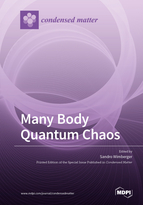Many Body Quantum Chaos
A special issue of Condensed Matter (ISSN 2410-3896).
Deadline for manuscript submissions: closed (31 December 2019) | Viewed by 35999
Special Issue Editor
Interests: nonlinear dynamics; quantum chaos; modelling and numerical simulation of complex quantum dynamical systems; light-matter interaction; non-equilibrium transport; floquet-bloch theory; exact diagonalizations; ultracold quantum gases; (spinor) Bose-Einstein condensates; open and dissipative systems; classical and quantum localization phenomena; nonlinear and many-body tunneling; atoms in external fields; control and synchronization of multi-mode systems; quantum walks
Special Issue Information
Dear Colleagues,
The field of chaos in many-body quantum systems has a long history, going back to Wigner’s simple models for heavy nuclei. Quantum chaos is being investigated in a broad variety of experimental platforms such as heavy nuclei, driven (few-electron) atoms, ultracold quantum gases and photonic or microwave realizations. Quantum chaos nowadays plays a new and important role in many branches of physics, from condensed matter problems of many-body localization, including (pre)thermalization studies in closed and open quantum systems, and the question of dynamical stability relevant for quantum information and quantum simulation. This Special Issue addresses theory and experiment, methods from classical chaos, semiclassics, random matrix theory, as well as many-body condensed matter physics.
The Special Issue is dedicated to Prof. Shmuel Fishman, who was one of the major representatives of the field over almost four decades and who recently passed away.
Prof. Sandro Wimberger
Guest Editor
Manuscript Submission Information
Manuscripts should be submitted online at www.mdpi.com by registering and logging in to this website. Once you are registered, click here to go to the submission form. Manuscripts can be submitted until the deadline. All submissions that pass pre-check are peer-reviewed. Accepted papers will be published continuously in the journal (as soon as accepted) and will be listed together on the special issue website. Research articles, review articles as well as short communications are invited. For planned papers, a title and short abstract (about 100 words) can be sent to the Editorial Office for announcement on this website.
Submitted manuscripts should not have been published previously, nor be under consideration for publication elsewhere (except conference proceedings papers). All manuscripts are thoroughly refereed through a single-blind peer-review process. A guide for authors and other relevant information for submission of manuscripts is available on the Instructions for Authors page. Condensed Matter is an international peer-reviewed open access quarterly journal published by MDPI.
Please visit the Instructions for Authors page before submitting a manuscript. The Article Processing Charge (APC) for publication in this open access journal is 1600 CHF (Swiss Francs). Submitted papers should be well formatted and use good English. Authors may use MDPI's English editing service prior to publication or during author revisions.
Keywords
- nonlinear dynamics
- thermalization in closed and open quantum systems
- Anderson localization
- many-body localization
- quantum transport
- quantum chaos
- random matrix theory
- quantum (chaos) control
- quantum simulation
- atoms in external fields
- quantum statistics
- quantum-to-classical transition






